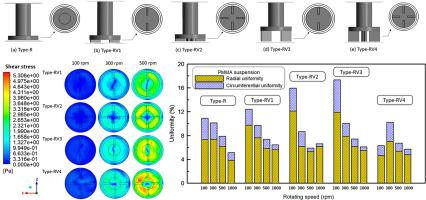Quantifying cake uniformity and filtration performance: Effects of disk geometries and operation conditions on dynamic filtration
IF 6.3
3区 工程技术
Q1 ENGINEERING, CHEMICAL
Journal of the Taiwan Institute of Chemical Engineers
Pub Date : 2025-09-20
DOI:10.1016/j.jtice.2025.106415
引用次数: 0
Abstract
Background
Shear-enhanced dynamic filtration significantly reduces cake fouling compared to conventional cross-flow filtration methods. Designing disk geometries for achieving high cake uniformity and low power consumption offers a promising and efficient solution to this challenge.
Methods
This study aims to demonstrate the effect of disk geometry and operating conditions on cake uniformity and filtration performance in dynamic filtration of particulate suspensions. CFD model was developed for five types of rotating disks in dynamic filtration. Cake mass distribution was inferred directly from simulation results using empirical equations. A simplified relationship between filtration flux, transmembrane pressure, and shear stress was modeled using power-law regression.
Significant findings
The results showed that the increase in shear stress was most pronounced for Type-RV4 and least for Type-RV1. The cake uniformity analysis indicated that the UT values decreased as the rotating speed increased, with Type-R achieving the best overall uniformity at ω = 1000 rpm. A comparison of specific energy results across various disk types showed that Type-RV4 at low rotating speed had the optimal designs for removing particles owing to its high flux and relatively low power consumption. Potential strategies are proposed for the sustainable development of dynamic filtration in solid-liquid industrial applications.

量化滤饼均匀性和过滤性能:圆盘几何形状和操作条件对动态过滤的影响
与传统的横流过滤方法相比,剪切增强的动态过滤显著减少了滤饼污染。设计磁盘几何形状以实现高饼均匀性和低功耗,为解决这一挑战提供了一个有前途的高效解决方案。方法在颗粒悬浮液的动态过滤过程中,考察圆盘几何形状和操作条件对滤饼均匀性和过滤性能的影响。建立了五种旋转圆盘在动态过滤中的CFD模型。利用经验方程直接从模拟结果中推断饼的质量分布。采用幂律回归方法建立了过滤通量、跨膜压力和剪切应力之间的简化关系模型。结果表明,rv4型的剪切应力增加最为明显,而rv1型的剪切应力增加最少。饼均匀性分析表明,UT值随着转速的增加而降低,其中r型在ω = 1000 rpm时整体均匀性最佳。对不同类型圆盘的比能结果进行比较,结果表明,低转速下的rv4型圆盘具有较高的通量和相对较低的功耗,具有最佳的颗粒去除设计。提出了动态过滤在固液工业应用中可持续发展的潜在策略。
本文章由计算机程序翻译,如有差异,请以英文原文为准。
求助全文
约1分钟内获得全文
求助全文
来源期刊
CiteScore
9.10
自引率
14.00%
发文量
362
审稿时长
35 days
期刊介绍:
Journal of the Taiwan Institute of Chemical Engineers (formerly known as Journal of the Chinese Institute of Chemical Engineers) publishes original works, from fundamental principles to practical applications, in the broad field of chemical engineering with special focus on three aspects: Chemical and Biomolecular Science and Technology, Energy and Environmental Science and Technology, and Materials Science and Technology. Authors should choose for their manuscript an appropriate aspect section and a few related classifications when submitting to the journal online.

 求助内容:
求助内容: 应助结果提醒方式:
应助结果提醒方式:


